Determining the Flexible Ramping Capacity of Electric Vehicles to Enhance Locational Flexibility
Abstract
:1. Introduction
2. Methodology
2.1. Flexible Ramping Product
2.2. EV Utilization for FRP
2.2.1. EV State Estimation
2.2.2. EV Available Energy and Power Estimation
3. Mathematical Formulation
3.1. Objective Function
3.2. Constraints
3.2.1. Power Balance
3.2.2. Resource Constraints
Generator Constraints
EV Constraints
3.2.3. System and Zonal FRP Constraints
3.2.4. Transmission Constraints
Zonal Deployment Transmission Constraints
4. Case Studies
4.1. Problem Formulation
4.1.1. Low Variability in Renewable Power—Case (a)
4.1.2. High Variability in Renewable Power—Case (b)
4.1.3. EV Market Penetration Rate Increase—Case (c)
4.1.4. Necessity of Considering the Transmission Constraint—Case (d)
5. Conclusions
Acknowledgments
Author Contributions
Conflicts of Interest
Nomenclature
| Indices and Sets | |
| i,I | Index and set for units |
| z,Z | Index and set for zones |
| n,N | Index and set for nodes |
| x,X | Index and set for EV fleets |
| l | Index for transmission constraints |
| S | Set for EV state categories (pc, fc, pl} |
| U | Set for ramping product categories {FRU, FRD, EVRU, EVRD} |
| Parameters | |
| ms | Mean value of EV states s |
| σs | Standard deviation of EV states s |
| Ps | Probability of EV states s |
| rmax,dis | Maximum EV discharging rate |
| rmax,cha | Maximum EV charging rate |
| VOLL | Value of lost load |
| Upper limit for the power output of unit i | |
| Lower limit for the power output of unit i | |
| RCiRCi | Ramp capability of unit i |
| η+ | Discharging coefficient of EV |
| η− | Charging coefficient of EV |
| εini | Initial energy level of EV |
| Εreq | Required energy level of EV |
| System ramping up requirement at time t | |
| System ramping down requirement at time t | |
| rpn,t | Renewable power output of node n at time t |
| dn,t | Demand of node n at time t |
| RPt | Vector of renewable power at time t |
| Dt | Vector of demand at time t |
| Hl,n,t | Sensitivity to transmission constraint l of node n at time t |
| Aggregated sensitivity for ramping product U to transmission constraint l of zone z at time t | |
| Flow limit for transmission constraint l at time t | |
| Variables | |
| EVEdis | Aggregated energy capacity of EV for discharging |
| EVEcha | Aggregated energy capacity of EV for charging |
| EVPdis | Aggregated power of EV for charging |
| EVPcha | Aggregated power of EV for discharging |
| EV discharging power of fleet x at time t | |
| EV charging power of fleet x at time t | |
| pi,t | Power output of unit i at time t |
| nln,t | Net load of node n at time t |
| FRUi,t | Ramping up of unit i at time t |
| FRDi,t | Ramping down of unit i at time t |
| EVRUx,t | EV ramping up of fleet x at time t |
| EVRDx,t | EV ramping down of fleet x at time t |
| CLSt | Load shedding cost at time t |
| LSt | Load shedding volume at time t |
| Pt | Vector of cleared generator energy at time t |
| EVt | Vector of cleared EV energy at time t |
| Functions | |
| Ptr(·) | Probability function of the number of traveling EVs |
| Ppa(·) | Probability function of the number of parked EVs |
| KE(·) | Cumulative distribution function of the energy from the parked EV fleet |
| CGi(·) | Total production cost function of unit i |
| Production cost function of energy of unit i | |
| Production cost function of ramping product U of unit i | |
| CEVx(·) | Total EV cost function of fleet x |
| EV discharging cost function of fleet x | |
| EV charging cost function of fleet x | |
| Cost function of EV ramping product U of fleet x | |
| Fl,t(·) | Flow with transmission constraint l at time t |
Appendix A. Formulation Including Reserve
Appendix A.1. Objective Function
Appendix A.1. Objective FunctionAppendix A.2. Constraints
- -
- Resource Capability
- -
- System Reserve
- -
- Zonal Reserve
- -
- Reserve Up and FRU/FRD
- -
- Reserve Down and FRU/FRD
- -
- Contingency
References
- Holttinen, H.; Meibom, P.; Orths, A.; Lange, B.; O’Malley, M.; Tande, J.O.; Estanqueiro, A.; Gomez, E.; Söder, L.; Strbac, G.; et al. Impacts of large amounts of wind power on design and operation of power systems, results of IEA collaboration. Wind Energy 2011, 14, 179–192. [Google Scholar] [CrossRef]
- Eftekharnejad, S.; Vittal, V.; Heydt, G.T.; Keel, B.; Loehr, J. Impact of increased penetration of photovoltaic generation on power systems. IEEE Trans. Power Syst. 2013, 28, 893–901. [Google Scholar] [CrossRef]
- Gul, T.; Stenzel, T. Variability of Wind Power and Other Renewables: Management Options and Strategies; International Energy Agency: Paris, France, 2005. [Google Scholar]
- Kunz, H.; Hagens, N.J.; Balogh, S.B. The Influence of Output Variability from Renewable Electricity Generation on Net Energy Calculations. Energies 2014, 7, 150–172. [Google Scholar] [CrossRef]
- Banakar, H.; Luo, C.; Ooi, B.T. Impacts of wind power minute-to-minute variations on power system operation. IEEE Trans. Power Syst. 2008, 23, 150–160. [Google Scholar] [CrossRef]
- Makarov, Y.V.; Loutan, C.; Ma, J.; De Mello, P. Operational impacts of wind generation on California power systems. IEEE Trans. Power Syst. 2009, 24, 1039–1050. [Google Scholar] [CrossRef]
- Kassakian, J.G.; Schmalensee, R.; Desgroseilliers, G.; Heidel, T.D.; Afridi, K.; Farid, A.; Grochow, J.; Hogan, W.; Jacoby, H.; Kirtley, J.; et al. The Future of the Electric Grid; Massachusetts Institute of Technology (MIT): Cambridge, MA, USA, 2011. [Google Scholar]
- Lannoye, E.; Flynn, D.; O’Malley, M. Evaluation of power system flexibility. IEEE Trans. Power Syst. 2012, 27, 922–931. [Google Scholar] [CrossRef]
- Kirby, B.; Beuning, S.J.; Connolly, K.; Dangelmaier, L.; Rosso, A.D.; Frost, W.; Grant, W.; Guttromson, R.; Henson, B.; John, E.; et al. Operating Practices, Procedures, and Tools; North American Electric Reliability Corporation (NERC): Princeton, NJ, USA, 2011. [Google Scholar]
- EnerNex. NSP Wind Integration Study Prepared for Xcel Energy; EnerNex.: Knoxville, TN, USA, 2014. [Google Scholar]
- Wu, C.; Hug, G.; Kar, S. Risk-limiting economic dispatch for electricity markets with flexible ramping products. IEEE Trans. Power Syst. 2016, 31, 1990–2003. [Google Scholar] [CrossRef]
- Wang, B.; Hobbs, B.F. Real-time markets for flexiramp: A stochastic unit commitment-based analysis. IEEE Trans. Power Syst. 2016, 31, 846–860. [Google Scholar] [CrossRef]
- Wang, C.; Luh, P.B.S.; Navid, N. Ramp requirement design for reliable and efficient integration of renewable energy. IEEE Trans. Power Syst. 2017, 32, 562–571. [Google Scholar] [CrossRef]
- Navid, N.; Rosenwald, G. Market solutions for managing ramp flexibility with high penetration of renewable resource. IEEE Trans. Sustain. Energy 2012, 3, 784–790. [Google Scholar] [CrossRef]
- Xu, L.; Tretheway, D. Flexible Ramping Products: Revised Draft Final Proposal; California ISO: Folsom, CA, USA, 2014. [Google Scholar]
- Navid, N. Ramp Capability Product Design for MISO Markets; MISO: Saint Paul, MN, USA, 2013. [Google Scholar]
- MISO. Ramp Management. Available online: https://www.misoenergy.org/WhatWeDo/MarketEnhancements/Pages/RampManagement.aspx (accessed on 2 November 2017).
- Chen, R.; Wang, J.; Botterud, A.; Sun, H. Wind power providing flexible ramp product. IEEE Trans. Power Syst. 2017, 32, 2049–2061. [Google Scholar] [CrossRef]
- Cui, M.; Zhang, J.; Wu, H.; Hodge, B.M.; Ke, D.; Sun, Y. Wind power ramping product for increasing power system flexibility. In Proceedings of the Transmission and Distribution Conference and Exposition (T&D), Dallas, TX, USA, 3–5 May 2016. [Google Scholar]
- Zhang, B.; Kezunovic, M. Impact on power system flexibility by electric vehicle participation in ramp market. IEEE Trans. Smart Grid 2016, 7, 1285–1294. [Google Scholar] [CrossRef]
- Gottwalt, S.; Schuller, A.; Flath, C.; Schmeck, H.; Weinhardt, C. Assessing load flexibility in smart grids: Electric vehicles for renewable energy integration. In Proceedings of the Power and Energy Society General Meeting (PES), Vancouver, BC, Canada, 21–25 July 2013. [Google Scholar]
- Kempton, W.; Tomić, J. Vehicle-to-grid power implementation: From stabilizing the grid to supporting large-scale renewable energy. J. Power Sources 2005, 144, 280–294. [Google Scholar] [CrossRef]
- White, C.D.; Zhang, K.M. Using vehicle-to-grid technology for frequency regulation and peak-load reduction. J. Power Sources 2011, 196, 3972–3980. [Google Scholar] [CrossRef]
- Pavić, I.; Capuder, T.; Kuzle, I. Value of flexible electric vehicles in providing spinning reserve services. Appl. Energy 2015, 157, 60–74. [Google Scholar] [CrossRef]
- Ortega-Vazquez, M.A.; Bouffard, F.; Silva, V. Electric vehicle aggregator/system operator coordination for charging scheduling and services procurement. IEEE Trans. Power Syst. 2013, 28, 1806–1815. [Google Scholar] [CrossRef]
- Tomić, J.; Kempton, W. Using fleets of electric-drive vehicles for grid support. J. Power Sources 2007, 168, 459–468. [Google Scholar] [CrossRef]
- Tang, D.; Wang, P. Nodal Impact Assessment and Alleviation of Moving Electric Vehicle Loads: From Traffic Flow to Power Flow. IEEE Trans. Power Syst. 2016, 31, 4231–4242. [Google Scholar] [CrossRef]
- Khodayar, M.E.; Wu, L.; Li, Z. Electric vehicle mobility in transmission-constrained hourly power generation scheduling. IEEE Trans. Smart Grid 2013, 4, 779–788. [Google Scholar] [CrossRef]
- Sun, Y.; Zhong, J.; Li, Z.; Tian, W.; Shahidehpour, M. Stochastic scheduling of battery-based energy storage transportation system with the penetration of wind power. IEEE Trans. Sustain. Energy 2017, 8, 135–144. [Google Scholar] [CrossRef]
- Chen, Y.; Gribik, P.; Gardner, J. Incorporating post zonal reserve deployment transmission constraints into energy and ancillary service co-optimization. IEEE Trans. Power Syst. 2014, 29, 537–549. [Google Scholar] [CrossRef]
- Zheng, T.; Litvinov, E. Contingency-based zonal reserve modeling and pricing in a co-optimized energy and reserve market. IEEE Trans. Power Syst. 2008, 23, 277–286. [Google Scholar] [CrossRef]
- Chatterjee, D.; Hansen, C.; Howard, J.; Larson, K.; Li, S.; Merring, B.; Trotter, K.; Wang, C.; Fogarty, J. Ramp Capability Integration Technical Work; MISO: Saint Paul, MN, USA, 2016. [Google Scholar]
- International Energy Agency. Global EV Outlook: Two Million and Counting; International Energy Agency: Paris, France, 2017. [Google Scholar]
- Arias, N.B.; Tabares, A.; Franco, J.F.; Lavorato, M.; Romero, R. Robust joint expansion planning of electrical distribution systems and EV charging stations. IEEE Trans. Sustain. Energy 2017, PP, 1. [Google Scholar] [CrossRef]
- Guo, J.; Zhang, Y.; Chen, X.; Yousefi, S.; Guo, C.; Wang, Y. Spatial stochastic vehicle traffic modeling for VANETs. IEEE Trans. Intell. Transp. Syst. 2017, PP, 1–10. [Google Scholar] [CrossRef]
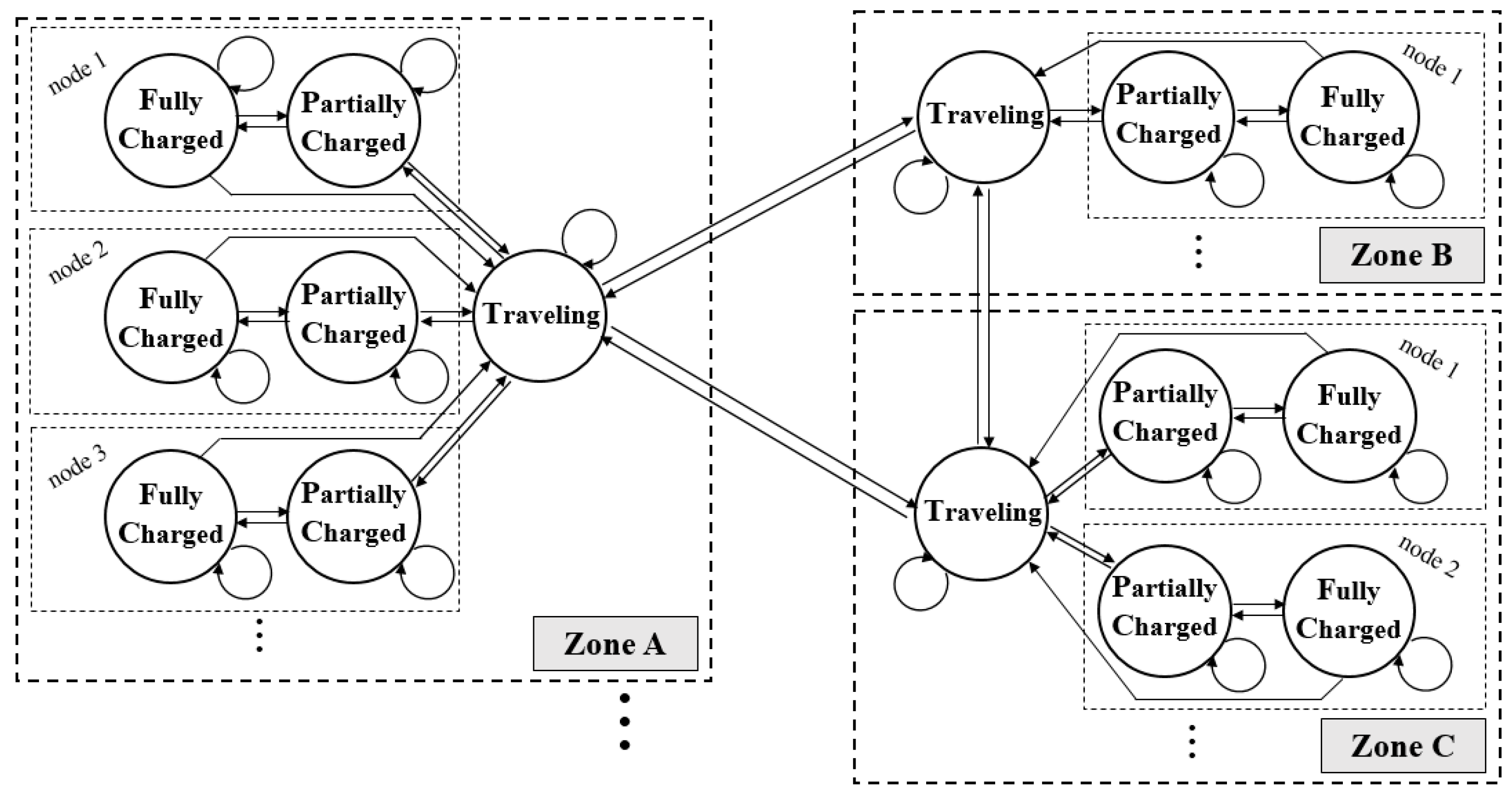

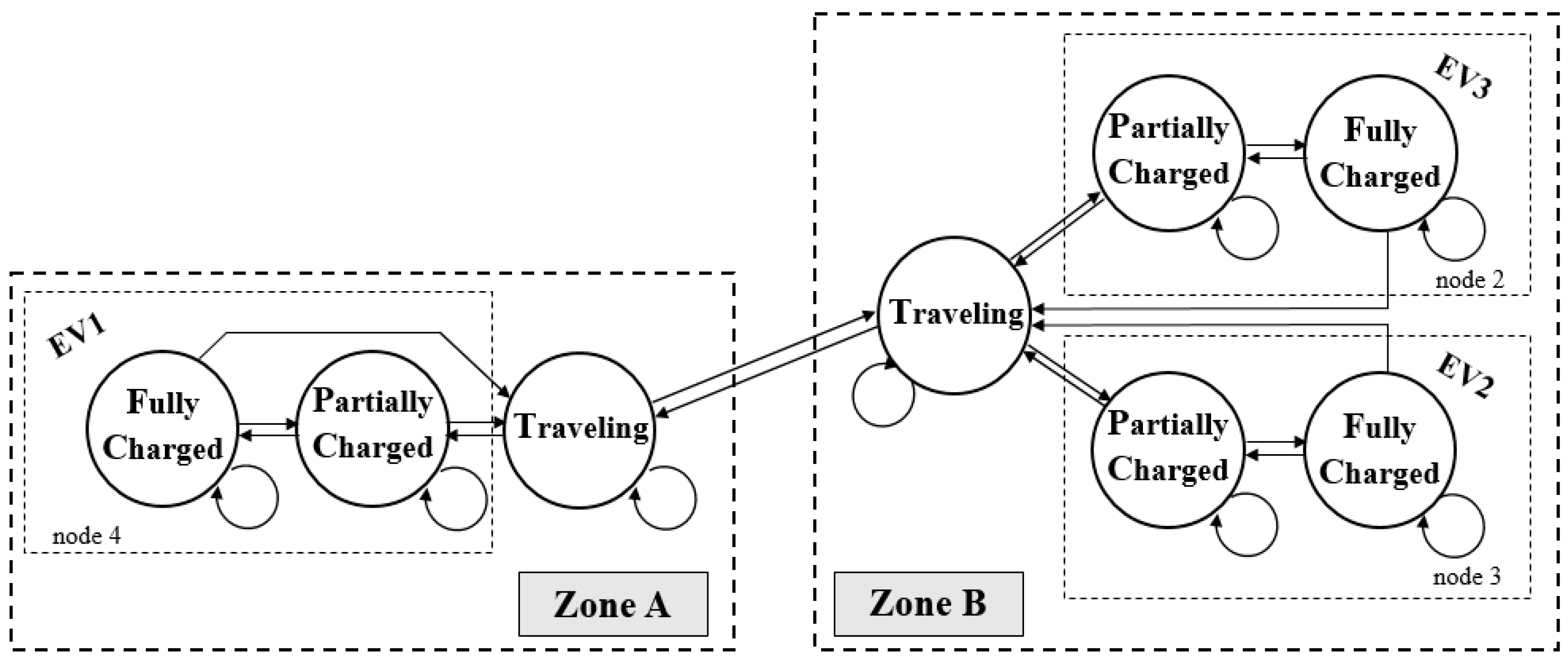
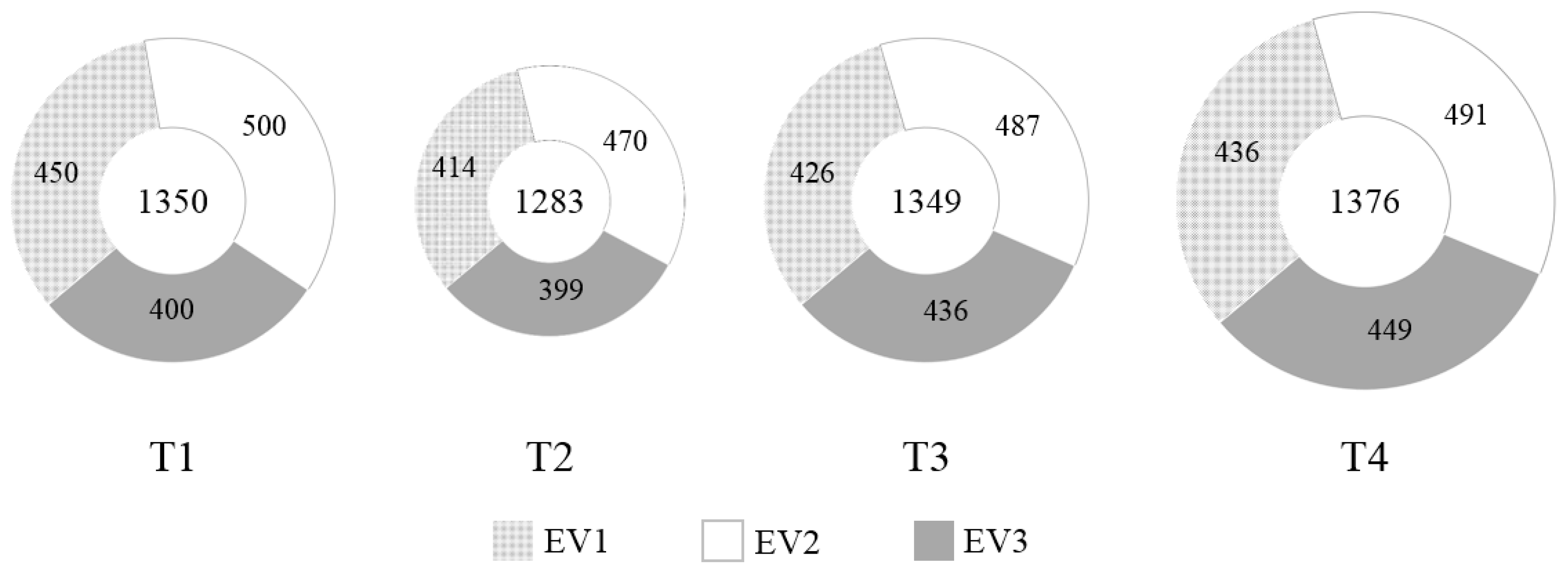
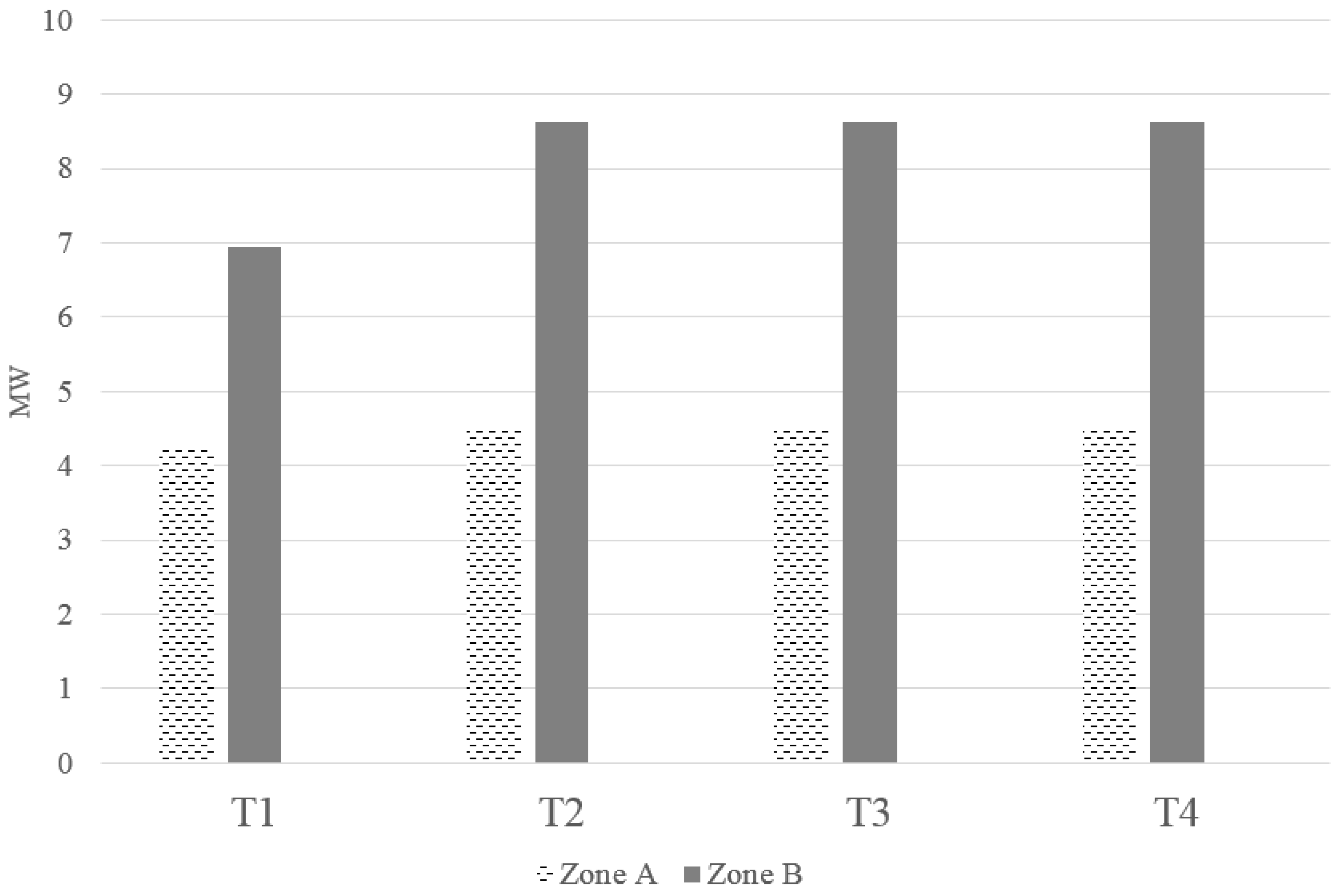
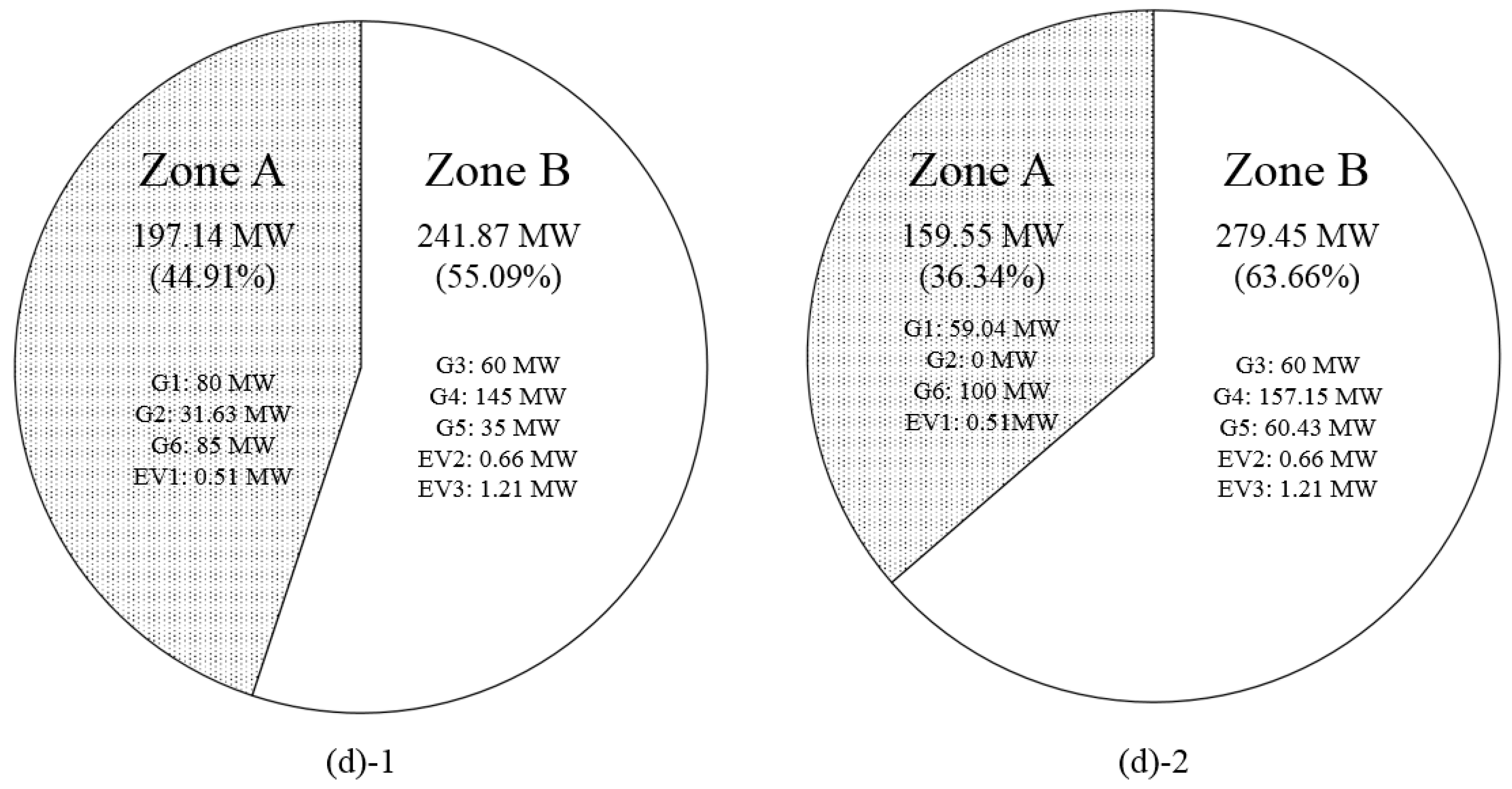
| Generator | Min (MW) | Max (MW) | Ramp Rate (MW/min) | Offer Price ($/MWh) | Initial Output |
|---|---|---|---|---|---|
| G1 | 0 | 80 | 4 | 10 | 50 |
| G2 | 0 | 80 | 4 | 10.1 | 25 |
| G3 | 0 | 60 | 1 | 8 | 60 |
| G4 | 0 | 160 | 1 | 25 | 160 |
| G5 | 0 | 160 | 1 | 30 | 50 |
| G6 | 0 | 100 | 1 | 15 | 100 |
| Sensitivity | 0.6 | −0.08 | −0.04 | 0.12 | 0.3 |
| T1 | T2 | T3 | T4 | T5 | T6 | ||
|---|---|---|---|---|---|---|---|
| Load (MW) | 498 | 504 | 513 | 501 | 507 | 510 | |
| Renewable output (MW) | Low variability (a) | 68 | 70 | 74 | 72 | 68 | 64 |
| High variability (b) | 68 | 76 | 70 | 71 | 66 | 60 | |
| EV, No Utilization for FRU (a)-1 Operating Cost: $11,009 | EV, Utilization for FRU (a)-2 Operating Cost: $10,933 | ||||||||
|---|---|---|---|---|---|---|---|---|---|
| Cost Saving: $76 (0.69%) | |||||||||
| (MW) | T1 | T2 | T3 | T4 | T1 | T2 | T3 | T4 | |
| G1 | Energy | 51.09 | 59.49 | 59.51 | 53.5 | 54.51 | 59.52 | 59.04 | 58.86 |
| FRU | 6 | 0 | 0 | 9 | 1.83 | 0 | 1.05 | 0 | |
| FRD | 0 | 0 | 12 | 0 | 0 | 0 | 12 | 0 | |
| G2 | Energy | 5 | 0 | 0 | 0 | 5 | 0 | 0 | 0 |
| FRU | 0 | 0 | 0 | 9 | 0 | 0 | 0 | 2.53 | |
| FRD | 0 | 0 | 0 | 0 | 0 | 0 | 0 | 0 | |
| G3 | Energy | 60 | 60 | 60 | 60 | 60 | 60 | 60 | 60 |
| FRU | 0 | 0 | 0 | 0 | 0 | 0 | 0 | 0 | |
| FRD | 0 | 10 | 0 | 0 | 0 | 10 | 0 | 0 | |
| G4 | Energy | 155 | 160 | 155 | 150 | 155.64 | 160 | 159.26 | 154.26 |
| FRU | 5 | 0 | 5 | 10 | 4.36 | 0 | 0.74 | 5.74 | |
| FRD | 0 | 10 | 0 | 0 | 0 | 10 | 0 | 0 | |
| G5 | Energy | 55 | 58.51 | 62.96 | 67.96 | 52.19 | 57.19 | 58.11 | 58.50 |
| FRU | 10 | 10 | 10 | 10 | 10 | 10 | 10 | 10 | |
| FRD | 0 | 10 | 0 | 0 | 0 | 10 | 0 | 0 | |
| G6 | Energy | 100 | 100 | 99.13 | 100 | 100 | 100 | 100 | 100 |
| FRU | 0 | 0 | 0 | 0 | 0 | 0 | 0 | 0 | |
| FRD | 10 | 10 | 0 | 0 | 10 | 10 | 0 | 0 | |
| EV1 | Energy | 0.52 | −0.53 | 0.51 | −0.52 | 0.52 | −0.53 | 0.51 | −0.52 |
| EVRU | x | x | x | x | 0 | 0 | 0 | 0 | |
| EV2 | Energy | 1.61 | −1.64 | 0.68 | −0.69 | 0.89 | −0.9 | 0.86 | −0.88 |
| EVRU | x | x | x | x | 2.59 | 5.21 | 3.45 | 5.19 | |
| EV3 | Energy | 1.79 | −1.82 | 1.22 | −1.25 | 1.25 | −1.28 | 1.21 | −1.24 |
| EVRU | x | x | x | x | 2.22 | 5.59 | 3.1 | 5.55 | |
| EV, No Utilization for FRU (b)-1 Operating Cost: $12,457 | EV, Utilization for FRU (b)-2 Operating Cost: $10,956 | ||||||||
|---|---|---|---|---|---|---|---|---|---|
| Cost Saving: $1501 (12.05%) | |||||||||
| (MW) | T1 | T2 | T3 | T4 | T1 | T2 | T3 | T4 | |
| EV1 | Energy | 1.49 | −1.52 | 0.53 | −0.54 | 1.49 | −1.52 | 1.44 | −1.47 |
| EVRU | x | x | x | x | 0 | 0 | 0 | 0 | |
| EV2 | Energy | 1.8 | −1.84 | 0.68 | −0.7 | 1.8 | −1.84 | 1.75 | −1.78 |
| EVRU | x | x | x | x | 1.67 | 6.15 | 2.57 | 6.09 | |
| EV3 | Energy | 1.79 | −1.82 | 1.22 | −1.25 | 1.79 | −1.82 | 1.73 | −1.77 |
| EVRU | x | x | x | x | 1.69 | 6.13 | 2.58 | 6.08 | |
| EV Penetration Rate | Operating Cost | Load Shedding |
|---|---|---|
| 1% (a)-2 | $10,933 | x |
| 2% (c)-1 | $10,941 | x |
| 3% (c)-2 | $13,002 | T2, L3 1.76 MW |
| Network Constraint Not Considered (d)-1 Operating Cost: $10,150 | Network Constraint Considered (d)-2 Operating Cost: $10,933 | ||||||||
|---|---|---|---|---|---|---|---|---|---|
| (MW) | T1 | T2 | T3 | T4 | T1 | T2 | T3 | T4 | |
| G1 | Energy | 67.55 | 80 | 80 | 80 | 54.51 | 59.52 | 59.04 | 58.86 |
| FRU | 0 | 0 | 0 | 0 | 1.83 | 0 | 1.05 | 0 | |
| FRD | 0 | 0 | 12 | 0 | 0 | 0 | 12 | 0 | |
| G2 | Energy | 5 | 16.5 | 31.63 | 41.42 | 5 | 0 | 0 | 0 |
| FRU | 0 | 0 | 12 | 9 | 0 | 0 | 0 | 2.53 | |
| FRD | 0 | 0 | 0 | 0 | 0 | 0 | 0 | 0 | |
| G3 | Energy | 60 | 60 | 60 | 60 | 60 | 60 | 60 | 60 |
| FRU | 0 | 0 | 0 | 0 | 0 | 0 | 0 | 0 | |
| FRD | 10 | 10 | 0 | 0 | 0 | 10 | 0 | 0 | |
| G4 | Energy | 155 | 150 | 145 | 140 | 155.64 | 160 | 159.26 | 154.26 |
| FRU | 5 | 0 | 0 | 10 | 4.36 | 0 | 0.74 | 5.74 | |
| FRD | 10 | 10 | 0 | 0 | 0 | 10 | 0 | 0 | |
| G5 | Energy | 45 | 40 | 35 | 30 | 52.19 | 57.19 | 58.11 | 58.5 |
| FRU | 10 | 10 | 0 | 10 | 10 | 10 | 10 | 10 | |
| FRD | 10 | 10 | 0 | 0 | 0 | 10 | 0 | 0 | |
| G6 | Energy | 95 | 90 | 85 | 80 | 100 | 100 | 100 | 100 |
| FRU | 5 | 0 | 0 | 0 | 0 | 0 | 0 | 0 | |
| FRD | 10 | 10 | 0 | 0 | 10 | 10 | 0 | 0 | |
| EV1 | Energy | 0.52 | −0.53 | 0.51 | −0.52 | 0.52 | −0.53 | 0.51 | −0.52 |
| EVRU | 1 | 0 | 0 | 0 | 0 | 0 | 0 | 0 | |
| EV2 | Energy | 0.68 | −0.69 | 0.66 | −0.7 | 0.89 | −0.9 | 0.86 | −0.88 |
| EVRU | 0 | 0 | 0 | 0 | 2.59 | 5.21 | 3.45 | 5.19 | |
| EV3 | Energy | 1.25 | −1.28 | 1.21 | −1.24 | 1.25 | −1.28 | 1.21 | −1.24 |
| EVRU | 0 | 0 | 0 | 0 | 2.22 | 5.59 | 3.1 | 5.55 | |
© 2017 by the authors. Licensee MDPI, Basel, Switzerland. This article is an open access article distributed under the terms and conditions of the Creative Commons Attribution (CC BY) license (http://creativecommons.org/licenses/by/4.0/).
Share and Cite
Kim, D.; Kwon, H.; Kim, M.-K.; Park, J.-K.; Park, H. Determining the Flexible Ramping Capacity of Electric Vehicles to Enhance Locational Flexibility. Energies 2017, 10, 2028. https://doi.org/10.3390/en10122028
Kim D, Kwon H, Kim M-K, Park J-K, Park H. Determining the Flexible Ramping Capacity of Electric Vehicles to Enhance Locational Flexibility. Energies. 2017; 10(12):2028. https://doi.org/10.3390/en10122028
Chicago/Turabian StyleKim, Dam, Hungyu Kwon, Mun-Kyeom Kim, Jong-Keun Park, and Hyeongon Park. 2017. "Determining the Flexible Ramping Capacity of Electric Vehicles to Enhance Locational Flexibility" Energies 10, no. 12: 2028. https://doi.org/10.3390/en10122028





